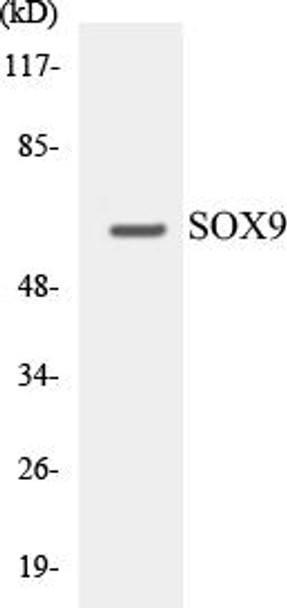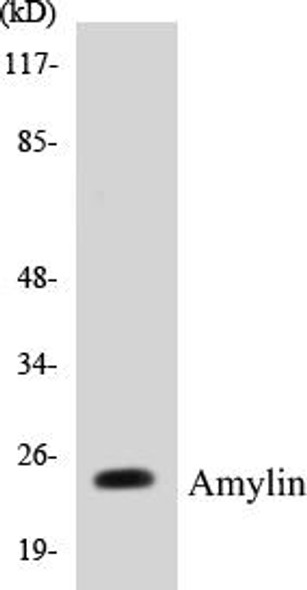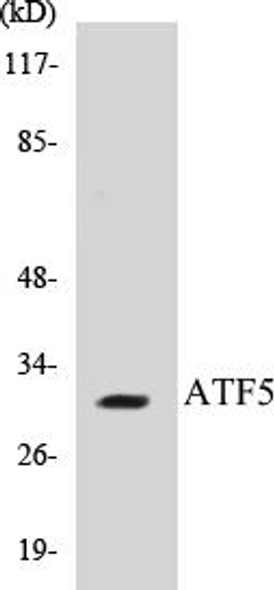Description
SOX9 Colorimetric Cell-Based ELISA Kit
The SOX9 Colorimetric Cell-based ELISA Kit is a powerful tool for detecting and quantifying SOX9 protein levels in cell lysates and tissue extracts. This kit offers high sensitivity and specificity, allowing for accurate and reliable results.SOX9 is a key transcription factor that plays a critical role in cell differentiation and development, particularly in chondrogenesis and cartilage formation. Dysregulation of SOX9 has been implicated in various diseases, including skeletal disorders and certain types of cancer.
With the SOX9 Colorimetric Cell-based ELISA Kit, researchers can gain valuable insights into the role of SOX9 in various biological processes and disease states. This kit is ideal for a wide range of research applications, making it an essential tool for scientists studying cell biology, developmental biology, and disease mechanisms.
| Product Name: | SOX9 Colorimetric Cell-Based ELISA Kit |
| Product Code: | CBCAB00087 |
| ELISA Type: | Cell-Based |
| Target: | SOX9 |
| Reactivity: | Human, Mouse |
| Dynamic Range: | > 5000 Cells |
| Detection Method: | Colorimetric 450 nmStorage/Stability:4°C/6 Months |
| Format: | 96-Well Microplate |
The SOX9 Colorimetric Cell-Based ELISA Kit is a convenient, lysate-free, high throughput and sensitive assay kit that can detect SOX9 protein expression profile in cells. The kit can be used for measuring the relative amounts of SOX9 in cultured cells as well as screening for the effects that various treatments, inhibitors (ie siRNA or chemicals), or activators have on SOX9.
Qualitative determination of SOX9 concentration is achieved by an indirect ELISA format. In essence, SOX9 is captured by SOX9-specific primary antibodies while the HRP-conjugated secondary antibodies bind the Fc region of the primary antibody. Through this binding, the HRP enzyme conjugated to the secondary antibody can catalyze a colorimetric reaction upon substrate addition. Due to the qualitative nature of the Cell-Based ELISA, multiple normalization methods are needed:
| 1. | A monoclonal antibody specific for human GAPDH is included to serve as an internal positive control in normalizing the target absorbance values. |
| 2. | Following the colorimetric measurement of HRP activity via substrate addition, the Crystal Violet whole-cell staining method may be used to determine cell density. After staining, the results can be analysed by normalizing the absorbance values to cell amounts, by which the plating difference can be adjusted. |
| Database Information: | Gene ID: 6662, UniProt ID: P48436, OMIM: 114290/608160, Unigene: Hs.647409 |
| Gene Symbol: | SOX9 |
| Sub Type: | None |
| UniProt Protein Function: | SOX9: Plays an important role in the normal skeletal development. May regulate the expression of other genes involved in chondrogenesis by acting as a transcription factor for these genes. Defects in SOX9 are the cause of campomelic dysplasia (CMD1). CMD1 is a rare, often lethal, dominantly inherited, congenital osteochondrodysplasia, associated with male- to-female autosomal sex reversal in two-thirds of the affected karyotypic males. A disease of the newborn characterized by congenital bowing and angulation of long bones, unusually small scapulae, deformed pelvis and spine and a missing pair of ribs. Craniofacial defects such as cleft palate, micrognatia, flat face and hypertelorism are common. Various defects of the ear are often evident, affecting the cochlea, malleus incus, stapes and tympanum. Most patients die soon after birth due to respiratory distress which has been attributed to hypoplasia of the tracheobronchial cartilage and small thoracic cage. Defects in SOX9 are the cause of 46,XX sex reversal type 2 (SRXX2). SRXX2 is a condition in which male gonads develop in a genetic female (female to male sex reversal). |
| UniProt Protein Details: | Protein type:DNA-binding; Transcription factor Chromosomal Location of Human Ortholog: 17q24.3 Cellular Component: nucleoplasm; nucleus; protein complex Molecular Function:chromatin binding; protein binding; protein kinase activity; RNA polymerase II transcription factor activity, enhancer binding; transcription factor activity Biological Process: cAMP-mediated signaling; cartilage condensation; cartilage development; cell fate specification; chromatin remodeling; epidermal growth factor receptor signaling pathway; epithelial to mesenchymal transition; hair follicle development; male germ-line sex determination; male gonad development; negative regulation of apoptosis; negative regulation of chondrocyte differentiation; negative regulation of epithelial cell proliferation; negative regulation of immune system process; negative regulation of myoblast differentiation; negative regulation of ossification; negative regulation of photoreceptor cell differentiation; negative regulation of transcription, DNA-dependent; nucleosome assembly; otic vesicle formation; positive regulation of cell proliferation; positive regulation of chondrocyte differentiation; positive regulation of epithelial cell differentiation; positive regulation of epithelial cell proliferation; positive regulation of mesenchymal cell proliferation; positive regulation of phosphoinositide 3-kinase cascade; positive regulation of protein amino acid phosphorylation; positive regulation of transcription from RNA polymerase II promoter; positive regulation of transcription, DNA-dependent; prostate gland development; protein complex assembly; regulation of apoptosis; regulation of cell proliferation; retina development in camera-type eye; Sertoli cell differentiation; signal transduction; skeletal development; somatic stem cell maintenance; spermatogenesis; tissue homeostasis Disease: 46,xy Sex Reversal 10; Campomelic Dysplasia |
| NCBI Summary: | The protein encoded by this gene recognizes the sequence CCTTGAG along with other members of the HMG-box class DNA-binding proteins. It acts during chondrocyte differentiation and, with steroidogenic factor 1, regulates transcription of the anti-Muellerian hormone (AMH) gene. Deficiencies lead to the skeletal malformation syndrome campomelic dysplasia, frequently with sex reversal. [provided by RefSeq, Jul 2008] |
| UniProt Code: | P48436 |
| NCBI GenInfo Identifier: | 1351096 |
| NCBI Gene ID: | 6662 |
| NCBI Accession: | P48436.1 |
| UniProt Secondary Accession: | P48436,Q53Y80, |
| UniProt Related Accession: | P48436 |
| Molecular Weight: | 56,137 Da |
| NCBI Full Name: | Transcription factor SOX-9 |
| NCBI Synonym Full Names: | SRY-box 9 |
| NCBI Official Symbol: | SOX9 |
| NCBI Official Synonym Symbols: | CMD1; SRA1; CMPD1; SRXX2; SRXY10 |
| NCBI Protein Information: | transcription factor SOX-9 |
| UniProt Protein Name: | Transcription factor SOX-9 |
| Protein Family: | Transcription factor |
| UniProt Gene Name: | SOX9 |
| UniProt Entry Name: | SOX9_HUMAN |
| Component | Quantity |
| 96-Well Cell Culture Clear-Bottom Microplate | 2 plates |
| 10X TBS | 24 mL |
| Quenching Buffer | 24 mL |
| Blocking Buffer | 50 mL |
| 15X Wash Buffer | 50 mL |
| Primary Antibody Diluent | 12 mL |
| 100x Anti-Phospho Target Antibody | 60 µL |
| 100x Anti-Target Antibody | 60 µL |
| Anti-GAPDH Antibody | 60 µL |
| HRP-Conjugated Anti-Rabbit IgG Antibody | 12 mL |
| HRP-Conjugated Anti-Mouse IgG Antibody | 12 mL |
| SDS Solution | 12 mL |
| Stop Solution | 24 mL |
| Ready-to-Use Substrate | 12 mL |
| Crystal Violet Solution | 12 mL |
| Adhesive Plate Seals | 2 seals |
The following materials and/or equipment are NOT provided in this kit but are necessary to successfully conduct the experiment:
- Microplate reader able to measure absorbance at 450 nm and/or 595 nm for Crystal Violet Cell Staining (Optional)
- Micropipettes with capability of measuring volumes ranging from 1 µL to 1 ml
- 37% formaldehyde (Sigma Cat# F-8775) or formaldehyde from other sources
- Squirt bottle, manifold dispenser, multichannel pipette reservoir or automated microplate washer
- Graph paper or computer software capable of generating or displaying logarithmic functions
- Absorbent papers or vacuum aspirator
- Test tubes or microfuge tubes capable of storing ≥1 ml
- Poly-L-Lysine (Sigma Cat# P4832 for suspension cells)
- Orbital shaker (optional)
- Deionized or sterile water
*Note: Protocols are specific to each batch/lot. For the correct instructions please follow the protocol included in your kit.
| Step | Procedure |
| 1. | Seed 200 µL of 20,000 adherent cells in culture medium in each well of a 96-well plate. The plates included in the kit are sterile and treated for cell culture. For suspension cells and loosely attached cells, coat the plates with 100 µL of 10 µg/ml Poly-L-Lysine (not included) to each well of a 96-well plate for 30 minutes at 37°C prior to adding cells. |
| 2. | Incubate the cells for overnight at 37°C, 5% CO2. |
| 3. | Treat the cells as desired. |
| 4. | Remove the cell culture medium and rinse with 200 µL of 1x TBS, twice. |
| 5. | Fix the cells by incubating with 100 µL of Fixing Solution for 20 minutes at room temperature. The 4% formaldehyde is used for adherent cells and 8% formaldehyde is used for suspension cells and loosely attached cells. |
| 6. | Remove the Fixing Solution and wash the plate 3 times with 200 µL 1x Wash Buffer for five minutes each time with gentle shaking on the orbital shaker. The plate can be stored at 4°C for a week. |
| 7. | Add 100 µL of Quenching Buffer and incubate for 20 minutes at room temperature. |
| 8. | Wash the plate 3 times with 1x Wash Buffer for 5 minutes each time. |
| 9. | Add 200 µL of Blocking Buffer and incubate for 1 hour at room temperature. |
| 10. | Wash 3 times with 200 µL of 1x Wash Buffer for 5 minutes each time. |
| 11. | Add 50 µL of 1x primary antibodies (Anti-SOX9 Antibody and/or Anti-GAPDH Antibody) to the corresponding wells, cover with Parafilm and incubate for 16 hours (overnight) at 4°C. If the target expression is known to be high, incubate for 2 hours at room temperature. |
| 12. | Wash 3 times with 200 µL of 1x Wash Buffer for 5 minutes each time. |
| 13. | Add 50 µL of 1x secondary antibodies (HRP-Conjugated AntiRabbit IgG Antibody or HRP-Conjugated Anti-Mouse IgG Antibody) to corresponding wells and incubate for 1.5 hours at room temperature. |
| 14. | Wash 3 times with 200 µL of 1x Wash Buffer for 5 minutes each time. |
| 15. | Add 50 µL of Ready-to-Use Substrate to each well and incubate for 30 minutes at room temperature in the dark. |
| 16. | Add 50 µL of Stop Solution to each well and read OD at 450 nm immediately using the microplate reader. |
(Additional Crystal Violet staining may be performed if desired – details of this may be found in the kit technical manual.)






